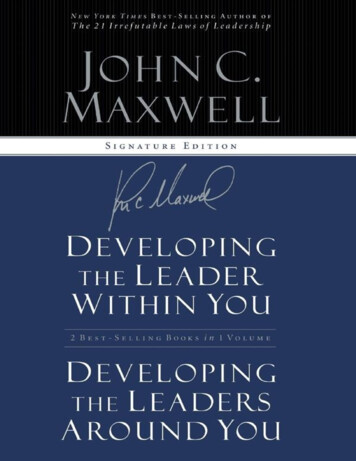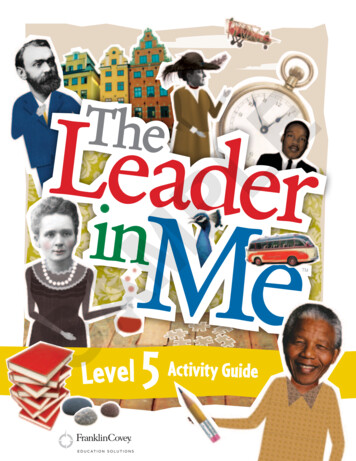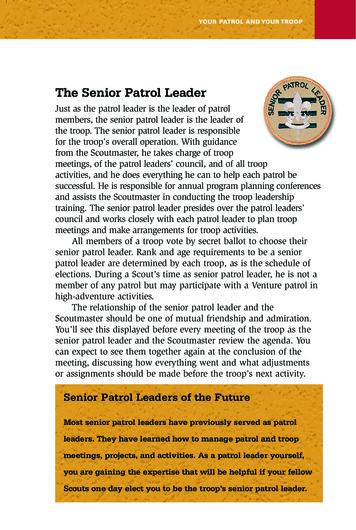
Transcription
DEVELOPINGthe LEADERWITHIN YOUDEVELOPINGthe LEADERSAROUND YOUJOHN C. MAXWELLNEW YORK TIMES BEST-SELLING AUTHOR OFTHE 21 IRREFUTABLE LAWS OF LEADERSHIP
Developing the Leader Within You 1993 by Maxwell Motivation, Inc.Developing the Leaders Around You 1995 by Maxwell Motivation, Inc.All rights reserved. No portion of this book may be reproduced, stored in a retrieval system, or transmittedin any form or by any means—electronic, mechanical, photocopy, recording, scanning, or other—except forbrief quotations in critical reviews or articles, without the prior written permission of the publisher.Published in Nashville, Tennessee, by Thomas Nelson. Thomas Nelson is a registered trademark of ThomasNelson, Inc.Published in association with Yates & Yates, www.yates2.com.Thomas Nelson, Inc., titles may be purchased in bulk for educational, business, fund-raising, or salespromotional use. For information, please e-mail SpecialMarkets@ThomasNelson.com.Scripture quotations are from THE NEW KING JAMES VERSION. 1982 by Thomas Nelson, Inc. Usedby permission. All rights reserved.ISBN 978-1-4002-8045-2 (hardcover)ISBN 978-1-4002-8057-5 (IE)Printed in the United States of America08 09 10 11 12 RRD 7 6 5 4 3 2 1
DEVELOPINGthe LEADERWITHIN YOU
This book is dedicated to the man I most admire.A friend whose touch warmed me;A mentor whose wisdom guided me;An encourager whose words lifted me;A leader I love to follow . . .My father,Melvin Maxwell
CONTENTSIntroduction1. The Definition of Leadership:INFLUENCE2. The Key to Leadership:PRIORITIES3. The Most Important Ingredient of Leadership:INTEGRITY4. The Ultimate Test of Leadership:CREATING POSITIVE CHANGE5. The Quickest Way to Gain Leadership:PROBLEM SOLVING6. The Extra Plus in Leadership:ATTITUDE7. Developing Your Most Appreciable Asset:PEOPLE8. The Indispensable Quality of Leadership:VISION9. The Price Tag of Leadership:SELF-DISCIPLINE10. The Most Important Lesson of Leadership:STAFF DEVELOPMENTEpilogueNotes
INTRODUCTIONIt was a moment I will never forget. I was lecturing on the subject ofleadership, and we had just taken a fifteen-minute break. A man named Bobrushed up to me and said, “You have saved my career! Thank you so much.” Ashe turned to walk away, I stopped him and asked, “How have I ‘saved’ yourcareer?” He replied, “I’m fifty-three years old and for the last seventeen years Ihave been in a position that demands leadership. Up until recently I havestruggled, acutely aware of my lack of leadership skills and success. Last year Iattended your leadership seminar and learned principles that I immediatelybegan applying in my work situation. And it happened. People began to followmy direction—slowly at first, but now quite readily. I had plenty of experiencebut no expertise. Thanks for making me a leader!”Testimonials like Bob’s have encouraged me to devote much of my time todeveloping leaders. It is the reason why I hold leadership seminars in the UnitedStates and other countries about ten times a year. It is the reason for this book.What you are about to read is a culmination of skills learned in twenty yearsof leading people. For more than twenty years I have taught these leadershipprinciples and watched with great satisfaction as men and women have becomemore effective in leading others. Now I have the opportunity to share them withyou.THE KEY TO SUCCESS IN AN ENDEAVORIS THE ABILITY TO LEAD OTHERSSUCCESSFULLYEverything rises and falls on leadership. Whenever I make that statement thelisteners are tempted to change it to, “Almost everything rises and falls onleadership.” Most people have a desire to look for the exception instead of thedesire to become exceptional.Right now you lead at a certain skill level. For the sake of teaching thisprinciple, let’s say that on a scale of 1 to 10, your leadership skills reach the
level of 6. This is what I know: The effectiveness of your work will never riseabove your ability to lead and influence others. You cannot produce consistentlyon a level higher than your leadership. In other words, your leadership skillsdetermine the level of your success— and the success of those who work aroundyou.Recently I read these words in Newsweek magazine from the president ofHyatt Hotels: “If there is anything I have learned in my 27 years in the serviceindustry, it is this: 99 percent of all employees want to do a good job. How theyperform is simply a reflection of the one for whom they work.”1 This humorousstory underscores the importance of effective leadership: During a sales meeting,the manager was berating the sales staff for their dismally low sales figures.“I’ve had just about enough of poor performance and excuses,” he said. “If youcan’t do the job, perhaps there are other salespeople out there who would jumpat the chance to sell the worthy products that each of you has the privilege torepresent.” Then, pointing to a newly recruited, retired pro-football player, hesaid, “If a football team isn’t winning, what happens? The players are replaced.Right?”The question hung heavy for a few seconds; then the ex-football playeranswered, “Actually, sir, if the whole team was having trouble, we usually got anew coach.”2LEADERSHIP CAN BE TAUGHTLeadership is not an exclusive club for those who were “born with it.” Thetraits that are the raw materials of leadership can be acquired. Link them up withdesire and nothing can keep you from becoming a leader. This book will supplythe leadership principles. You must supply the desire. Leonard Ravenhill in “TheLast Days Newsletter” tells about a group of tourists who were visiting apicturesque village. As they walked by an old man sitting beside a fence, onetourist asked in a patronizing way, “Were any great men born in this village?”The old man replied, “Nope, only babies.”Leadership is developed, not discovered. The truly “born leader” will alwaysemerge; but, to stay on top, natural leadership characteristics must be developed.In working with thousands of people desirous of becoming leaders, I havediscovered they all fit in one of four categories or levels of leadership: THE
LEADING LEADER: is born with leadership qualities. has seen leadership modeled throughout life. has learned added leadership through training. has self-discipline to become a great leader.Note: Three out of four of these qualities are acquired.THE LEARNED LEADER: has seen leadershipmodeled most of life. has learned leadership through training. has self-discipline to be a great leader.Note: All three qualities are acquired.THE LATENT LEADER: has just recently seenleadership modeled. is learning to be a leader through training. has self-discipline to become a good leader.Note: All three qualities are acquired.THE LIMITED LEADER: has little or no exposure to leaders. has little or no exposure to leadership training. has desire to become a leader.Note: All three can be acquired.
THERE ARE VERY FEW LEADERSHIP BOOKS;MOST DEAL WITH MANAGEMENTThere seems to be a great deal of confusion over the difference between“leadership” and “management.”John W. Gardner, former Secretary of the U.S. Department of Health,Education, and Welfare, who directed a leadership study project in Washington,D.C., has pinpointed five characteristics that set “leader managers” apart from“run-of-the-mill managers”: 1. Leader managers are long-term thinkers who seebeyond the day’s crisis and the quarterly report.2. Leader managers’ interests in their companies do not stop with the unitsthey head. They want to know how all of the company’s departmentsaffect one another, and they are constantly reaching beyond their specificareas of influence.3. Leader managers put heavy emphasis on vision, values, and motivation.4. Leader managers have strong political skills to cope with conflictingrequirements of multiple constituents.5. Leader managers don’t accept the status quo.3Management is the process of assuring that the program and objectives of theorganization are implemented. Leadership, on the other hand, has to do withcasting vision and motivating people.People don’t want to be managed. They want to be lead. Whoeverheard of a world manager? World leader, yes. Education leader, yes.Political leader. Religious leader. Scout leader. Community leader.Labor leader. Business leader. Yes. They lead. They don’t manage.The carrot always wins over the stick. Ask your horse. You can leadyour horse to water, but you can’t manage him to drink. If you want tomanage somebody, manage yourself. Do that well and you’ll be readyto stop managing and start leading.4 Knowing how to do a job is the accomplishment of labor. Showing others is the accomplishment of a teacher. Making sure the work is done by others is the accomplishment of amanager.
Inspiring others to do better work is the accomplishment of a leader.My desire is that you be able to accomplish the work of a leader. This bookis dedicated to that goal. While you read this book and begin applying theseleadership principles, please be reminded of Bruce Larson. In his book Wind andFire, Larson points out some interesting facts about Sandhill cranes: “Theselarge birds, who fly great distances across continents, have three remarkablequalities. First, they rotate leadership. No one bird stays out in front all the time.Second, they choose leaders who can handle the turbulence. And then, all duringthe time one bird is leading, the rest are honking their affirmation.”Hopefully you will learn enough about leadership to take your place at thefront of the pack. While you are making that attempt, I will be honkingaffirmation to you with great pride and inner satisfaction.In every age there comes a time when leadership must come forth to meet theneeds of the hour. Therefore, there is no potential leader who does not find his orher time. Read this book and be ready to seize your moment!—John C. Maxwell
ONETHE DEFINITION OF LEADERSHIP:INFLUENCEEveryone talks about it; few understand it. Most people want it; few achieveit. There are over fifty definitions and descriptions of it in my personal files.What is this intriguing subject we call “leadership”?Perhaps because most of us want to be leaders, we become emotionallyinvolved when trying to define leadership. Or, perhaps because we know one,we try to copy his or her behavior and describe leadership as a personality. Askten people to define leadership and you’ll probably receive ten different answers.After more than five decades of observing leadership within my family andmany years of developing my own leadership potential, I have come to thisconclusion: Leadership is influence. That’s it. Nothing more; nothing less. Myfavorite leadership proverb is: He who thinketh he leadeth and hath no onefollowing him is only taking a walk.James C. Georges, of the ParTraining Corporation, said it quite effectively ina recent interview with Executive Communications:What is leadership? Remove for a moment the moral issues behind it, and there is only onedefinition: Leadership is the ability to obtain followers.Hitler was a leader and so was Jim Jones. Jesus of Nazareth, Martin Luther King, Jr., WinstonChurchill, and John F. Kennedy all were leaders. While their value systems and managementabilities were very different, each had followers.Once you define leadership as the ability to get followers, you work backward from that pointof reference to figure out how to lead.1Therein lies the problem. Most people define leadership as the ability toachieve a position, not to get followers. Therefore, they go after a position, rank,or title and, upon their arrival, think they have become a leader. This type ofthinking creates two common problems: those who possess the “status” of leaderoften experience the frustration of few followers, and those who lack the propertitles may not see themselves as leaders and therefore don’t develop theirleadership skills.My goal with this book is to help you accept leadership as influence (that is,the ability to get followers), and then work backward from that point to help you
learn how to lead. Each chapter is designed to place in your hand anotherprinciple that will assist your leadership development. This first chapter isdesigned to expand the level of your influence.INSIGHTS ABOUT INFLUENCEEVERYONE INFLUENCES SOMEONESociologists tell us that even the most introverted individual will influenceten thousand other people during his or her lifetime! This amazing statistic wasshared with me by my associate Tim Elmore. Tim and I concluded that each oneof us is both influencing and being influenced by others. That means that all ofus are leading in some areas, while in other areas we are being led. No one isexcluded from being a leader or a follower. Realizing your potential as a leaderis your responsibility. In any given situation with any given group, there is aprominent influencer. Let me illustrate. The mother may be the dominantinfluencer over a child in the morning before school begins. Mom may choosewhat to eat and what to wear. The child who is influenced before school maybecome the influencer of other children once school begins. Dad and Mom maymeet at a restaurant for lunch and both be influenced by the waiter, who suggeststhe house specialty. The time dinner is served in the evening may be set becauseof either the husband’s or wife’s work schedule.The prominent leader of any group is quite easily discovered. Just observethe people as they gather. If an issue is to be decided, who is the person whoseopinion seems most valuable? Who is the one others watch the most when theissue is being discussed? Who is the one with whom people quickly agree? Mostimportantly, who is the one the others follow? Answers to these questions willhelp you discern who the real leader is in a particular group.WE NEVER KNOW WHO OR HOW MUCH WEINFLUENCEThe most effective way to understand the power of influence is to think ofthe times you have been touched by the influence of a person or an event. Big
events leave marks on all our lives and memories. For example, ask a couple ofpeople born prior to 1930 what they were doing when they heard that PearlHarbor had been bombed, and they will describe in detail their feelings andsurroundings when they heard the terrible news. Ask someone born before 1955to describe what he or she was doing when the news that John F. Kennedy hadbeen shot was broadcast. Again, you will find no loss for words. A similarresponse occurs with the younger generation when asked about the day theChallenger blew up. These were big events that touched everyone.Think also of the little things or people who influenced you in a powerfulway. In reflecting on my own life, I think of the influence of a camp I attendedas a youth and how it helped determine my career choice. I think of my seventhgrade teacher, Glen Leatherwood . . . the bubble lights on our Christmas tree thatgave me the “Christmas feeling” every year . . . the affirming note I receivedfrom a professor in college . . . The list is endless. Life consists of influencerswho daily find us vulnerable to their impressions and, therefore, have helpedmold us into the persons we are. J. R. Miller said it well: “There have beenmeetings of only a moment which have left impressions for life, for eternity. Noone can understand that mysterious thing we call influence . . . yet . . . everyoneof us continually exerts influence, either to heal, to bless, to leave marks ofbeauty; or to wound, to hurt, to poison, to stain other lives.”2This truth also sobers me when I realize my influence as a father. A friendgave me a plaque with this poem on it. Now it sits on my desk:The Little Chap Who Follows MeA careful man I want to be,A little fellow follows me;I do not dare to go astrayFor fear he’ll go the self-same way.I cannot once escape his eyes.Whate’er he sees me do he tries.Like ME he says he’s going to be—That little chap who follows me.I must remember as I go
I must remember as I goThrough summer suns and winter snows,I am building for the years to be—That little chap who follows me.THE BEST INVESTMENT IN THE FUTUREIS A PROPER INFLUENCE TODAYThe issue is not whether you influence someone. What needs to be settled iswhat kind of an influencer you will be. Will you grow into your leadershipskills? In the book Leaders, Bennis and Nanus say, “The truth is that leadershipopportunities are plentiful and within reach of most people.”3You must believe that! The rest of this chapter is committed to helping youmake a difference tomorrow by becoming a better leader today.INFLUENCE IS A SKILL THAT CAN BEDEVELOPEDRobert Dilenschneider, the CEO of Hill and Knowlton, a worldwide publicrelations agency, is one of the nation’s major influence brokers. He skillfullyweaves his persuasive magic in the global arena, where governments andmegacorporations meet. He wrote a book entitled Power and Influence, in whichhe shares the idea of the “power triangle” to help leaders get ahead. He says,“The three components of this triangle are communication, recognition, andinfluence. You start to communicate effectively. This leads to recognition andrecognition in turn leads to influence.”4We can increase our influence and our leadership potential. Out of thisconviction I have developed a teaching tool to assist others in understandingtheir levels of leadership so they can increase their levels of influence (see charton page 13).THE FIVE LEVELS OF LEADERSHIP
LEVEL 1: POSITIONThis is the basic entry level of leadership. The only influence you have isthat which comes with a title. People who stay at this level get into territorialrights, protocol, tradition, and organizational charts. These things are notnegative unless they become the basis for authority and influence, but they arepoor substitutes for leadership skills.A person may be “in control” because he has been appointed to a position. Inthat position he may have authority. But real leadership is more than havingauthority; it is more than having the technical training and following the properprocedures. Real leadership is being the person others will gladly andconfidently follow. A real leader knows the difference between being the bossand being a leader, as illustrated by the following:The boss drives his workers; the leader coaches them.The boss depends on authority; the leader on goodwill.The boss inspires fear; the leader inspires enthusiasm.The boss says “I”; the leader, “we.”The boss fixes the blame for the breakdown; the leader fixes thebreakdown.The boss knows how it is done; the leader shows how.The boss says, “Go”; the leader says, “Let’s go!”CHARACTERISTICS OF A “POSITIONALLEADER”Security is based on title, not talent. The story is told of a private in WorldWar I who shouted on the battlefield, “Put out that match!” only to find to hischagrin that the offender was General “Black Jack” Pershing. When the private,who feared severe punishment, tried to stammer out his apology, GeneralPershing patted him on the back and said, “That’s all right, son. Just be glad I’mnot a second lieutenant.” The point should be clear. The higher the person’s levelof true ability and the resulting influence, the more secure and confident he
becomes.This level is often gained by appointment. All other levels are gained byability. Leo Durocher was coaching at first base in an exhibition game the Giantswere playing at West Point. One noisy cadet kept shouting at Leo and doing hisbest to upset him.“Hey, Durocher,” he hollered. “How did a little squirt like you get into themajor leagues?”Leo shouted back, “My congressman appointed me!”5People will not follow a positional leader beyond his stated authority. Theywill only do what they have to do when they are required to do it. Low morale isalways present. When the leader lacks confidence, the followers lackcommitment. They are like the little boy who was asked by Billy Graham how tofind the nearest post office. When the lad told him, Dr. Graham thanked him andsaid, “If you’ll come to the convention center this evening, you can hear metelling everyone how to get to heaven.”“I don’t think I’ll be there,” the boy replied. “You don’t even know your wayto the post office.”Positional leaders have more difficulty working with volunteers, whitecollar workers, and younger people. Volunteers don’t have to work in theorganization, so there is no monetary leverage that a positional leader can use tomake them respond. White-collar workers are used to participating in decisionmaking and resent dictatorial leadership. Baby boomers in particular areunimpressed with symbols of authority.Most of us have been taught that leadership is a position. Frustration riseswithin us when we get out into the real world and find that few people follow usbecause of our titles. Our joy and success in leading others depend on ourabilities to keep climbing the levels of leadership.LEVEL 2: PERMISSIONFred Smith says, “Leadership is getting people to work for you when theyare not obligated.”6 That will only happen when you climb to the second level of
influence. People don’t care how much you know until they know how muchyou care. Leadership begins with the heart, not the head. It flourishes with ameaningful relationship, not more regulation.Leaders on the “position” level often lead by intimidation. They are like thechickens that Norwegian psychologist T. Schjelderup-Ebbe studied indeveloping the “pecking order” principle that today is used to describe all typesof social gatherings.Schjelderup-Ebbe found that in any flock one hen usually dominates all theothers. She can peck any other without being pecked in return. Second comes ahen that pecks all but the top hen, and the rest are arranged in descendinghierarchy, ending in one hapless hen that is pecked by all and can peck no one.In contrast to this, a person on the “permission” level will lead byinterrelationships. The agenda is not the pecking order but people development.On this level, time, energy, and focus are placed on the individual’s needs anddesires. A wonderful illustration of why it’s so critical to put people and theirneeds first is found in the story of Henry Ford in Amitai Etzioni’s book, ModernOrganizations:He made a perfect car, the Model T, that ended the need for any other car. He was totally productoriented. He wanted to fill the world with Model T cars. But when people started coming to himand saying, “Mr. Ford, we’d like a different color car,” he remarked, “You can have any coloryou want as long as it’s black.” And that’s when the decline started.People who are unable to build solid, lasting relationships will soon discoverthat they are unable to sustain long, effective leadership. (Chapter 7 of this book,“Developing Your Most Appreciable Asset: People,” will deal more extensivelywith this subject.) Needless to say, you can love people without leading them,but you cannot lead people without loving them.One day one of my staff members, Dan Reiland, shared an insight with methat I have never forgotten: “If level 1, Position, is the door to leadership, thenlevel 2, Permission, is the foundation.”Caution! Don’t try to skip a level. The most often skipped level is 2,Permission. For example, a husband goes from level 1, Position, a wedding daytitle, to level 3, Production. He becomes a great provider for the family, but inthe process he neglects the essential relationships that hold a family together.The family disintegrates, and so does the husband’s business. Relationshipsinvolve a process that provides the glue and much of the staying power for longterm, consistent production.
LEVEL 3: PRODUCTIONOn this level things begin to happen, good things. Profit increases. Morale ishigh. Turnover is low. Needs are being met. Goals are being realized.Accompanying this growth is the “big mo”—momentum. Leading andinfluencing others is fun. Problems are solved with minimum effort. Freshstatistics are shared on a regular basis with the people who undergird the growthof the organization. Everyone is results-oriented. In fact, results are the mainreason for the activity.This is a major difference between levels 2 and 3. On the “relationship”level, people get together just to get together. There is no other objective. On the“results” level, people come together to accomplish a purpose. They like to gettogether to get together, but they love to get together to accomplish something.In other words, they are results-oriented.They are like a character played by Jack Nicholson, who, while in arestaurant in a famous scene from the movie Five Easy Pieces, is told he cannotget a side order of toast. He comes up with an imaginative solution. First, heorders a chicken salad sandwich on toast. Then he instructs the waitress: “Nomayonnaise, but butter . . . and hold the chicken.”One of my favorite stories is about a newly hired traveling salesman whosent his first sales report to the home office. It stunned the brass in the salesdepartment because it was obvious that the new salesman was ignorant! This iswhat he wrote: “I seen this outfit which they ain’t never bot a dim’s worth ofnothin from us and I sole them some goods. I’m now goin to Chicawgo.”Before the man could be given the heave-ho by the sales manager, alongcame this letter from Chicago: “I cum hear and sole them haff a millyon.”Fearful if he did, and afraid if he didn’t fire the ignorant salesman, the salesmanager dumped the problem in the lap of the president. The following morning,the ivory-towered sales department members were amazed to see posted on thebulletin board above the two letters written by the ignorant salesman this memofrom the president: “We ben spendin two much time trying to spel instead oftrying to sel. Let’s watch those sails. I want everybody should read these lettersfrom Gooch who is on the rode doin a grate job for us and you should go out anddo like he done.”Obviously, any sales manager would prefer to have a salesman who can bothsell and spell. However, many people have produced great results who were not
“qualified.”LEVEL 4: PEOPLE DEVELOPMENTHow do you spot a leader? According to Robert Townsend, they come in allsizes, ages, shapes, and conditions. Some are poor administrators, while someare not overly bright. There is a clue: Since some people are mediocre, the trueleader can be recognized because somehow his people consistently demonstratesuperior performances.A leader is great, not because of his or her power, but because of his or herability to empower others. Success without a successor is failure. A worker’smain responsibility is developing others to do the work (see chapter 7).Loyalty to the leader reaches its highest peak when the follower haspersonally grown through the mentorship of the leader. Note the progression: atlevel 2, the follower loves the leader; at level 3, the follower admires the leader;at level 4, the follower is loyal to the leader. Why? You win people’s hearts byhelping them grow personally.One of the key players on my staff is Sheryl Fleisher. When she first joinedthe team, she was not a people person. I began to work closely with her until shetruly became a people person. Today she successfully develops others. There is abond of loyalty that Sheryl gives to my leadership, and we both know the reason.My time invested with her brought a positive change. She will never forget whatI have done for her. Interestingly, her time invested in the lives of others hasgreatly helped me. I will never forget what she has done for me, either.The core of leaders who surround you should all be people you havepersonally touched or helped to develop in some way. When that happens, loveand loyalty will be exhibited by those closest to you and by those who aretouched by your key leaders.There is, however, a potential problem of moving up the levels of influenceas a leader and becoming comfortable with the group of people you havedeveloped around you. You may not realize that many new people view you as a“position” leader because you have had no contact with them. The followingsuggestions will help you become a people developer:Walk slowly though the crowd. Have some way of keeping in touch with
everyone. When I was a pastor, I did this in my congregation of five thousandby: learning names through the pictorial church directory. making communication cards available to the congregation and reading thecards as they were turned in (about 250 were received weekly). reading every interview form of a membership applicant. reading and replying to letters that were sent to me. visiting one social event of each Sunday school class each year.Develop key leaders. I systematically meet with and teach those who areinfluencers within the organization. They, in turn, pass on to others what I havegiven them.LEVEL 5: PERSONHOODLittle time will be spent discussing this level, since most of us have not yetarrived at it. Only a lifetime of proven leadership will allow us to sit at level 5and reap the rewards that are eternally satisfying. I do this—someday I want tosit atop this level. It’s achievable.CLIMBING THE STEPS OF LEADERSHIPHere are some additional insights on the leadership-levels process:THE HIGHER YOU GO, THE LONGER IT TAKESEach time there is a change in your job or you join a new circle of friends,you start on the lowest level and begin to work yourself up the steps.THE HIGHER YOU GO,THE HIGHER THE LEVEL OF COMMITMENT
This increase in commitment is a two-way street. Greater commitment isdemanded not only from you, but from the other individuals involved. Wheneither the leader or the follower is unwilling to make the sacrifices a new leveldemands, influence will begin to decrease.THE HIGHER YOU GO, THE EASIER IT IS TOLEADNotice the progression from level 2 through level 4. The focus goes fromliking you, to liking what you do for the common interest of all concerned, toliking what you do for th
1. The Definition of Leadership: INFLUENCE 2. The Key to Leadership: PRIORITIES 3. The Most Important Ingredient of Leadership: INTEGRITY 4. The Ultimate Test of Leadership: CREATING POSITIVE CHANGE 5. The Quickest Way to Gain Leadership: PROBLEM SOLVING 6. The Extra Plus in Leadership: ATTITUDE 7. Developing Your Most Appreciable Asset: PEOPLE 8.










